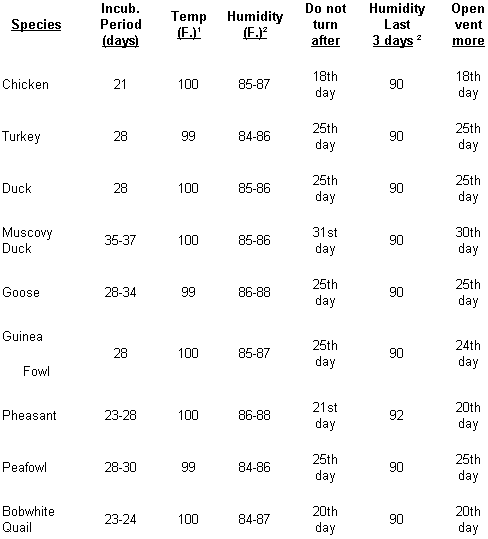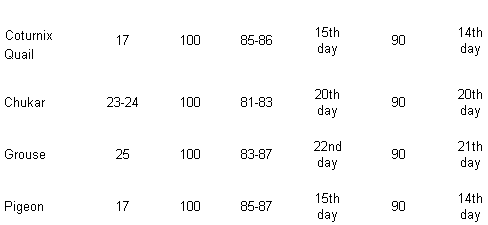



Important incubation factors
By the Mississippi State University Extension Service - When incubating any bird egg it is important to control the same factors of temperature, humidity, ventilation, and egg turning. The chart shown below lists the major incubation factors and the values of each that produces the best incubation conditions for the species of birds shown.
Important incubation factors - By the Mississippi State University Extension Service - When incubating any bird egg it is important to control the same factors of temperature, humidity, ventilation, and egg turning. The chart shown below lists the major incubation factors and the values of each that produces the best incubation conditions for the species of birds shown.
Poor results are most commonly produced with improper control of temperature and/or humidity. Improper control means that the temperature or humidity is too high or too low for a sufficient length of time that it interferes with the normal growth and development of the embryo. Poor results also occur from improper ventilation, egg turning and sanitation of the machines or eggs.
Obtain the best hatch by keeping the temperature at 100° F. throughout the entire incubation period when using a forced-air incubator. Minor fluctuations (less than ½ degree) above or below 100 degrees are tolerated, but do not let the temperatures vary more than a total of 1 degree. Prolonged periods of high or low temperatures will alter hatching success. High temperatures are especially serious. A forced-air incubator that is too warm tends to produce early hatches. One that runs consistently cooler tends to produce late hatches. In both cases the total chicks hatched will be reduced.
Maintain a still-air incubator at 102 degrees F. to compensate for the temperature layering within the incubator. Obtain the proper temperature reading by elevating the bulb of the thermometer to the same height as the top of the eggs when the eggs are laying horizontal. If the eggs are positioned in a vertical position, elevate the thermometer bulb to a point just below the top of the egg. The temperature is measured at the level where the embryos develop (at the top of the egg). Do not allow the thermometer's bulb to touch the eggs or incubator. Incorrect readings will result.
Humidity is carefully controlled to prevent unnecessary loss of egg moisture. The relative humidity in the incubator between setting and 3 days prior to hatching should remain at 58-60 percent or 84-86° F., wet-bulb. When hatching, the humidity is increased to 65 percent relative humidity or more.
Frequently there is confusion as to how the measurement of humidity is expressed. Most persons in the incubator industry refer to the level of humidity in terms of degrees F., (wet-bulb) rather than percent relative humidity. The two terms are interconvertible and actual humidity depends upon the temperature (F.) as measured with a dry-bulb thermometer. Conversion between the two humidity measurements can be made using a psychrometric table.
Rarely is the humidity too high in properly ventilated still-air incubators. The water pan area should be equivalent to one-half the floor surface area or more. Increased ventilation during the last few days of incubation and hatching may necessitate the addition of another pan of water or a wet sponge. Humidity is maintained by increasing the exposed water surface area.
Ventilation is very important during the incubation process. While the embryo is developing, oxygen enters the egg through the shell and carbon dioxide escapes in the same manner. As the chicks hatch, they require an increased supply of fresh oxygen. As embryos grow, the air vent openings are gradually opened to satisfy increased embryonic oxygen demand. Care must be taken to maintain humidity during the hatching period. Unobstructed ventilation holes, both above and below the eggs, are essential for proper air exchange.
Eggs must be turned at least 4-6 times daily during the incubation period. Do not turn eggs during the last 3 days before hatching. The embryos are moving into hatching position and need no turning. Keep the incubator closed during hatching to maintain proper temperature and humidity. The air vents should be almost fully open during the latter stages of hatching.
The eggs are initially set in the incubator with the large end up or horizontally with the large end slightly elevated. This enables the embryo to remain oriented in a proper position for hatching. Never set eggs with the small end upward.
In a still-air incubator, where the eggs are turned by hand, it may be helpful to place an "X" on one side of each egg and an "O" on the other side, using a pencil. This serves as an aide to determine whether all eggs are turned. When turning, be sure your hands are free of all greasy or dusty substances. Eggs soiled with oils suffer from reduced hatchability. Take extra precautions when turning eggs during the first week of incubation. The developing embryos have delicate blood vessels that rupture easily when severely jarred or shaken, thus killing the embryo.
The following table lists incubation requirements for various species of fowl.
 ¹ Measured at degrees F. in a forced-air incubator. For still-air incubators, add 2-3 degrees F.
² Measured as degrees F. using a wet-bulb thermometer. Use chart to convert to relative humidity.
¹ Measured at degrees F. in a forced-air incubator. For still-air incubators, add 2-3 degrees F.
² Measured as degrees F. using a wet-bulb thermometer. Use chart to convert to relative humidity.
Additional information on incubating eggs can be found in the Hatchery Management Guide
Source: Mississippi State University Extension Service - May 2004
Obtain the best hatch by keeping the temperature at 100° F. throughout the entire incubation period when using a forced-air incubator. Minor fluctuations (less than ½ degree) above or below 100 degrees are tolerated, but do not let the temperatures vary more than a total of 1 degree. Prolonged periods of high or low temperatures will alter hatching success. High temperatures are especially serious. A forced-air incubator that is too warm tends to produce early hatches. One that runs consistently cooler tends to produce late hatches. In both cases the total chicks hatched will be reduced.
Maintain a still-air incubator at 102 degrees F. to compensate for the temperature layering within the incubator. Obtain the proper temperature reading by elevating the bulb of the thermometer to the same height as the top of the eggs when the eggs are laying horizontal. If the eggs are positioned in a vertical position, elevate the thermometer bulb to a point just below the top of the egg. The temperature is measured at the level where the embryos develop (at the top of the egg). Do not allow the thermometer's bulb to touch the eggs or incubator. Incorrect readings will result.
Humidity is carefully controlled to prevent unnecessary loss of egg moisture. The relative humidity in the incubator between setting and 3 days prior to hatching should remain at 58-60 percent or 84-86° F., wet-bulb. When hatching, the humidity is increased to 65 percent relative humidity or more.
Frequently there is confusion as to how the measurement of humidity is expressed. Most persons in the incubator industry refer to the level of humidity in terms of degrees F., (wet-bulb) rather than percent relative humidity. The two terms are interconvertible and actual humidity depends upon the temperature (F.) as measured with a dry-bulb thermometer. Conversion between the two humidity measurements can be made using a psychrometric table.
Rarely is the humidity too high in properly ventilated still-air incubators. The water pan area should be equivalent to one-half the floor surface area or more. Increased ventilation during the last few days of incubation and hatching may necessitate the addition of another pan of water or a wet sponge. Humidity is maintained by increasing the exposed water surface area.
Ventilation is very important during the incubation process. While the embryo is developing, oxygen enters the egg through the shell and carbon dioxide escapes in the same manner. As the chicks hatch, they require an increased supply of fresh oxygen. As embryos grow, the air vent openings are gradually opened to satisfy increased embryonic oxygen demand. Care must be taken to maintain humidity during the hatching period. Unobstructed ventilation holes, both above and below the eggs, are essential for proper air exchange.
Eggs must be turned at least 4-6 times daily during the incubation period. Do not turn eggs during the last 3 days before hatching. The embryos are moving into hatching position and need no turning. Keep the incubator closed during hatching to maintain proper temperature and humidity. The air vents should be almost fully open during the latter stages of hatching.
The eggs are initially set in the incubator with the large end up or horizontally with the large end slightly elevated. This enables the embryo to remain oriented in a proper position for hatching. Never set eggs with the small end upward.
In a still-air incubator, where the eggs are turned by hand, it may be helpful to place an "X" on one side of each egg and an "O" on the other side, using a pencil. This serves as an aide to determine whether all eggs are turned. When turning, be sure your hands are free of all greasy or dusty substances. Eggs soiled with oils suffer from reduced hatchability. Take extra precautions when turning eggs during the first week of incubation. The developing embryos have delicate blood vessels that rupture easily when severely jarred or shaken, thus killing the embryo.
The following table lists incubation requirements for various species of fowl.


Additional information on incubating eggs can be found in the Hatchery Management Guide
Source: Mississippi State University Extension Service - May 2004









